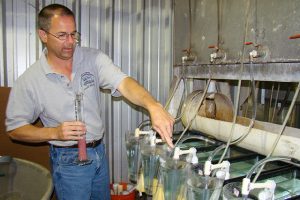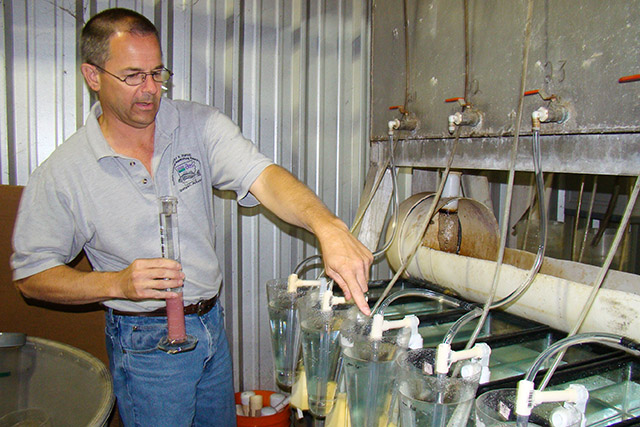by Sandra Avant, Agricultural Research Service

ARS aquatic toxicologist Dave Straus adds fish eggs to hatching chambers in a study at Keo Fish Farm.
Photo by Cindy Ledbetter, Agricultural Research Service
Agricultural Research Service (ARS) scientists previously compared the effectiveness of copper sulfate to treat catfish eggs against two current treatments—formalin and hydrogen peroxide. While both are U.S. Food and Drug Administration (FDA) approved, they are more expensive than copper sulfate. Hydrogen peroxide costs 89 cents per treatment, formalin costs 73 cents, and copper sulfate costs 2 cents.
To learn if copper sulfate was effective treating other types of fish eggs, fish toxicologist David Straus at the ARS Harry K. Dupree Stuttgart National Aquaculture Research Center in Stuttgart, Arkansas, treated sunshine (hybrid striped) bass eggs with copper sulfate. Straus and his team worked with hatchery managers of Keo Fish Farm, the largest producer of sunshine bass fry and fingerlings (young fish) in the world. They found that eggs treated with copper sulfate had nearly a 50 percent survival rate. Untreated eggs survive 28 percent of the time.
Copper sulfate proved a cheap and effective way of controlling fungus with sunshine bass eggs. Toxicity experiments on sunshine bass larvae also showed that copper sulfate was a safe and valuable resource for controlling fungus in hatcheries.
Scientists are working toward gaining FDA approval to use copper sulfate on catfish eggs to treat fungus as well as Ich—a parasite that infects the gills or skin of fish and eventually kills them.
Read more about this research in the February 2017 issue of AgResearch magazine.
ARS is USDA’s chief in-house scientific research agency.










